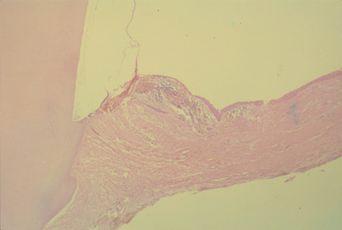Directions:
To view this case click on the different case tabs below.
As you tab through the case you will see photos. Click on each photo to see an enlargement.
When you have determined a diagnosis and treatment, select the Discussion tab.
Patient: 14 year old woman.
Chief Complaint:
Patient reports a slowly progressive enlargement.
Medical History:
No abnormalities are identified.
Dental History:
No abnormalities are identified.
Clinical Findings:
The progressive enlargement of the right face is of 4 years duration. The enlargement is nonpainful. Panoramic radiograph reveals a diffuse uniform radiopaque lesion of the right maxillary sinus. No other abnormalities are identified
There are no lab reports available for this case.
There are no charts available for this case.
Summary:
This lesion is slowly progressive, nonpainful, diffuse and uniformly radiopaque.
Lesions to Include/Exclude:
Exclude cysts, benign odontogenic tumors, benign nonodontogenic tumors, and other localized tumors because they are well-circumscribed.
Exclude inflammatory lesions because they are associated with pain or paresthesia and are linked to a traceable cause.
Exclude malignant neoplasms because they are associated with rapid growth and pain or paresthesia.
We can exclude primary diseases of bone because they involve multiple different locations in bone. In addition, we can exclude several lesions and diseases for the following reasons.
Exclude the radiolucent lesions because this lesion is diffusely radiopaque.
Exclude Paget's disease because of the age of the patient. Paget's disease involves multiple bones and has a characteristic "cotton wool" appearance radiographically.
Exclude osteopetrosis because it diffusely involves the entire skeleton and bone pain is a common symptom.
The history and radiographic appearance of this lesion strongly suggest the classical appearance for monostotic fibrous dysplasia.
| Lesion images | |
|---|---|
 |
 |
Management:
Fibrous dysplasia is difficult to treat due to the diffuse nature of its borders. Therefore, proper management includes observation without biopsy until bone growth stops, at which time cosmetic bony recontouring may be an option.
Prognosis:
Depends on the extent of bone involvement. Fibrous dysplasia may be disabling and cosmetically challenging, but is not life threatening. There have been case reports of osteosarcoma arising in fibrous dysplasia. This is quite rare, but the clinician should be concerned if sudden rapid growth appears in a lesion of fibrous dysplasia.